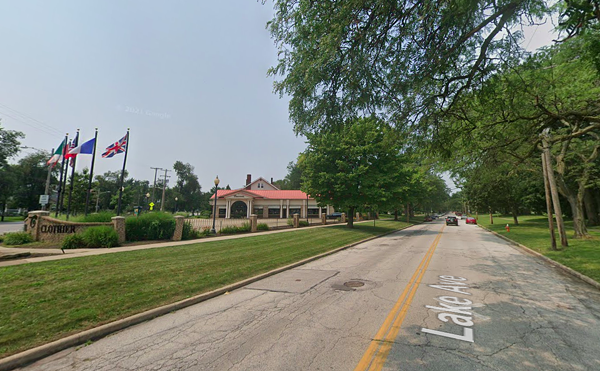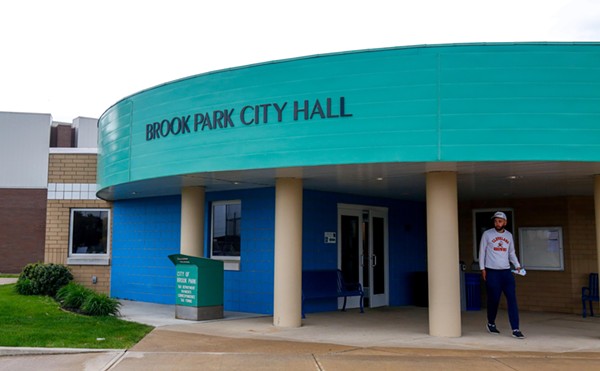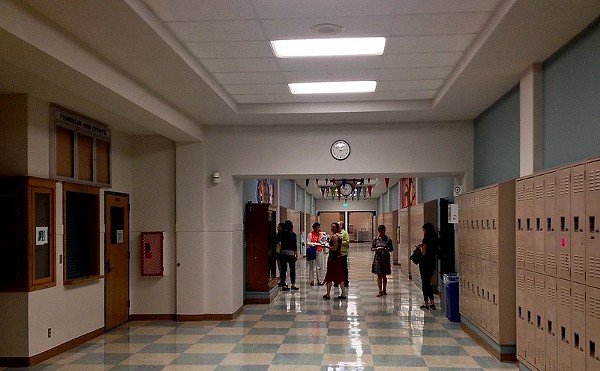PD/Cle.com Launches New Series on Education Modeled After "A Greater Cleveland"
Two reporters were embedded at an elementary school for a full year, while no one covered education.
By Sam Allard on Tue, Sep 20, 2022 at 2:30 pm
[
{
"name": "Ad - NativeInline - Injected",
"component": "38482495",
"insertPoint": "3",
"requiredCountToDisplay": "5"
},{
"name": "Real 1 Player (r2) - Inline",
"component": "38482494",
"insertPoint": "2/3",
"requiredCountToDisplay": "9"
}
]
You'd be forgiven for thinking that since the unceremonious booting of Plain Dealer education reporter Patrick O'Donnell — part of the 2020 massacre that killed the PD union and unified what were previously "separate but equal" print and digital newsrooms at the metro daily — Cleveland.com hasn't given much thought to the schools.
Certainly not the Cleveland Metropolitan School District, at any rate. During Covid, education was, in my opinion, Northeast Ohio's most criminally underreported beat. The Classroom had become a perilous ideological battleground, and the concerns of students, parents, teachers, and administrators were often in sharp conflict. Yet topics of rancorous debate, both nationally and locally, about virtual learning, student academic performance, social-emotional health, chronic absenteeism, faculty and staff compensation, long-term Covid strategies, facility modernization, etc. simply did not appear in the PD's pages. It was a vacuum.
The daily coverage one might expect from a reporter on the education beat during non-Covid times had likewise evaporated. There was nothing about Cleveland board of education meetings, nothing about state audits, nothing about test scores, union squabbles, PTA gripes; nary a breaking story about hirings, firings, awards or malfeasance; no photo ops at campus groundbreakings; no profiles of gifted student athletes from broken homes, troublemakers turned whiz kids, committed teachers raising funds to transform their classrooms. It had all disappeared! Poof!
So when the American Journalism Project announced its new local newsroom — the outfit now called Signal Cleveland — it seemed natural that one of its first job postings was for an education reporter. The funders and editors of that project recognized that there were swaths of darkness in the region's media grid, and that a city like Cleveland deserved a few more high-watt light bulbs, including one presiding over its school district. Readers needed more than occasional commentary about the scourge of Critical Race Theory fanatics on suburban school boards and state legislation on teachers and guns.
Ideastream Public Media understood the assignment as well and recently hired a new high-watt education reporter of its own, Conor Morris, the young buck lately of Report for America and the Northeast Ohio Solutions Journalism project.
And it's a good thing they did, given the spate of high-profile education news in recent weeks. CMSD chief Eric Gordon announced abruptly — though not really, for those in the know — that he'd be stepping down at the end of the current school year earlier this month. It was Signal's news editor, Mark Naymik, who broke the story on social media. And it was Ideastream's Morris who provided the most in-depth reporting about the escalating tension between the Justin Bibb administration and the Cleveland Teachers Union related to charter school expansion that lurked in the background of Gordon's decision. More about the Bibb-Gordon relationship will be revealed before long.
It has of course been distressing over the past two-plus years to witness the PD/Cleveland.com throwing in the towel on a crucial news beat, having evidently determined that the juice was no longer worth the squeeze when it came to CMSD. This was doubly distressing when they were simultaneously doing shit like hiring a reporter to cover the Cincinnati Bengals, (no doubt a response to bonkers NFL traffic on the site and editor Chris Quinn's obsession with being relevant statewide.)
But surprise! As it turns out, the PD/Cleveland.com has not abandoned education coverage. Instead, they now say, they've reinvented it.
Monday marked the launch of a new series on education at Cleveland.com called "Cleveland's Promise." Per the editors, it will attempt to show readers "the enormous challenges of educating children in poverty and what the school district is doing to overcome them." It is the result of an investment by the Quinn-led newsroom bordering on the absurd. Two reporters, Hannah Drown and Cameron Fields, have been embedded at Almira Elementary in Cleveland's West Boulevard neighborhood for more than a year to produce the stories that will comprise the series. In fact, they are still embedded at Almira, as the fourth-grade students they followed last year now enter fifth grade.
We were told by Chris Quinn in his most recent letter from the editor that the series will publish new installments every weekday for the first two weeks, then twice-weekly after that, with no end date in sight. There will eventually be "hundreds of stories" in the series, a grim prospect for Cleveland.com readers.
On its face, the project's aspirations are laudable. In the first story, published Monday, readers follow the pseudonymous sisters Sophia and Bailey as they go to school the day after their parents are arrested in an overnight home raid. It explains the elaborate support infrastructure at Almira and celebrates the school administrators and staff working behind the scenes to ensure the girls have everything they need in the harrowing aftermath of the ordeal.
This is the kind of narrative that, as Quinn correctly notes, provides intimate perspective beyond straightforward daily news coverage of CMSD. It may very well help readers understand (and come to support) the vast resources an urban school district requires to provide for its students, many of whom live in poverty and amidst barriers of every sort. That's a tremendous public service.
But just as with A Greater Cleveland, Cleveland.com's series on child poverty on which "Cleveland's Promise" is modeled, Quinn makes a fundamental mistake that may lead readers to disparage the series as "poverty porn." Quite simply, he's treating this "unprecedented" approach to education coverage as a substitute for traditional beat reporting instead of what it should be: an enhancement to it.
"For too many years to count, education reporting fell back on traditional coverage of school boards like governments," Quinn wrote in his editor's letter. "Lots of battles between the districts and the teachers’ unions. Discussions about money woes. School funding formulas. Standardized testing. School report cards. Charter schools. Educational strategies and theories."
Cleveland.com's Leila Atassi, the lead editor on the series, made virtually the same point in her introduction Monday.
"Traditional education reporting has always been about process and policy, covering school boards the way we cover governments and boiling the value of each district down to how well they score on annual state report cards," she wrote. "For CMSD, that shallow coverage, combined with their perennially struggling state ratings, has contributed to a wide gap of understanding about what really happens in Cleveland classrooms. Rare is the opportunity to see the reality of it up close – until now."
Notwithstanding the grandiose language and insufferable self-importance that attends these launches, the editors' introductions presuppose that readers of the PD/Cleveland.com have been getting a steady diet of traditional education coverage in recent years and have been unsatisfied.
Quite the opposite! As a reader I am desperate to read and understand more about the relationship between the city, the district and the teachers union. If there are battles, I haven't read anything about the opposing sides, or who's winning, in the PD. I am equally desperate to understand the district's financial picture, and the ways that my tax dollars are being deployed by the schools. Educational strategies and theories? Sounds interesting! Wish I knew anything about them! Alas, these discussions haven't appeared in the one place I'd expect to encounter them locally.
The fact is, it can be disorienting to see "reality up close" when we haven't seen it from afar for so long. It's like watching a movie with nothing but close-ups of actors' faces the whole time. Zoom out for God's sake! Zoom out!
Quinn writes that the project was conceived in consultation with Eric Gordon himself, who reportedly was the one to suggest the project as a spinoff of A Greater Cleveland. Gordon's granting "unprecedented access" to Cleveland.com is not surprising, then, as the stories are explicitly designed to paint a flattering picture of the district, its heroic personnel working against the odds, and its "inspiring, passionate" leader.
All that access, incidentally, wasn't enough to get Cleveland.com the scoop on Gordon's impending departure. And the two reporters who have been encamped at Almira for more than a year — not producing journalism for Cleveland.com the whole time, which, again, is head-spinning — didn't even write the breaking news item. City Hall reporter Courtney Astolfi was enlisted for that task. Former City Hall reporter Bob Higgs pitched in with a timeline of Gordon's accomplishments at CMSD the following day. Hannah Drown, one of the "Cleveland's Promise" reporters, did publish an interview with Gordon shortly thereafter, a sendoff titled "A legacy of dedication and passion for education" that's so fond and commendatory Gordon may well attach it to the application for his next job.
Readers are smart enough to intuit that far more occurred behind the scenes, and what they crave at this moment is the analysis and inside intel that a well-sourced beat reporter could provide.
The point, once again, is that journalism models need not be reinvented — disrupted, broken, innovated, whatever — to produce work that both informs and inspires readers. I always chuckle when Quinn stumbles upon the idea of "features" every few weeks on the Today in Ohio podcast or in his weekly letters. He'll remark that readers complain about too much negative news, and he responds by "innovating" things like a gardening column and stories about staffers' home renovations.
For the record, I do not regard that stuff as frivolous nonsense. In fact I'm fully in favor. These niche and personalized narratives tend to delight segments of a mass publication's readership and help them connect with the publication's writers. But like other media consumers, I support that content as a companion to hard news reporting, which still should be the newspaper's bread and butter. This dynamic, by the way — for the millennials and zoomers in the audience — used to be an absolutely standard component of newspaper operations. There was something called a features desk, the writers on which tackled longer, typically more lyrical, human-centered narratives that were meant to contextualize and animate important issues that writers on other desks (the city desk, for example) tackled in a daily way.
This is not new!
And "Cleveland's Promise" has all the ingredients of a fantastic feature story. I personally think it might have been most successful as a limited series published in installments to coincide with the school year. But in its current form, it's structured like a beat unto itself, with two reporters — two full-time reporters! — producing an ongoing stream of material from a single elementary school. Given the paper's depleted newsroom resources in general, and the absence of an education beat reporter in particular, the investment in the series is not just unusual. It's insane.
***
Sign up for Scene's weekly newsletters to get the latest on Cleveland news, things to do and places to eat delivered right to your inbox.
SCENE Supporters make it possible to tell the Cleveland stories you won’t find elsewhere.
Become a supporter today.
About The Author
Sam Allard
Sam Allard is the Senior Writer at Scene, in which capacity he covers politics and power and writes about movies when time permits. He's a graduate of the Medill School of Journalism at Northwestern University and the NEOMFA at Cleveland State. Prior to joining Scene, he was encamped in Sarajevo, Bosnia, on an...
Scroll to read more Cleveland News articles
Newsletters
Join Cleveland Scene Newsletters
Subscribe now to get the latest news delivered right to your inbox.















